Angers, France, June 3rd - 6th, 1910
The world's first town-to-town aeroplane race

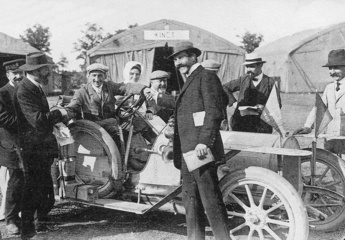

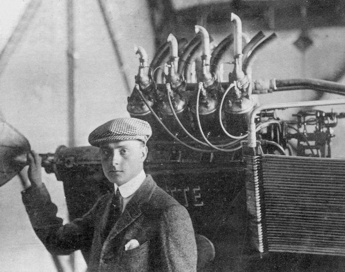
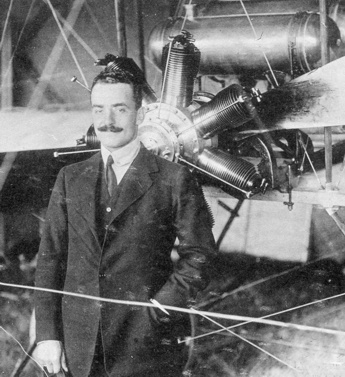




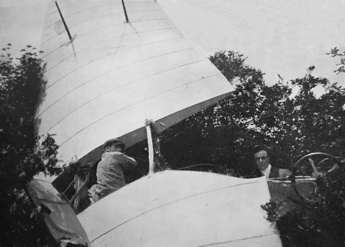
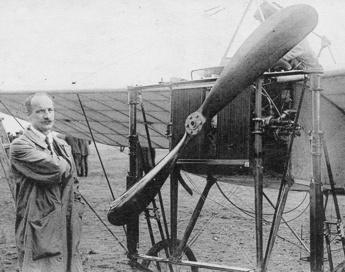
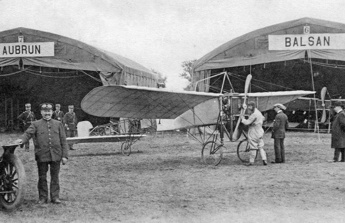



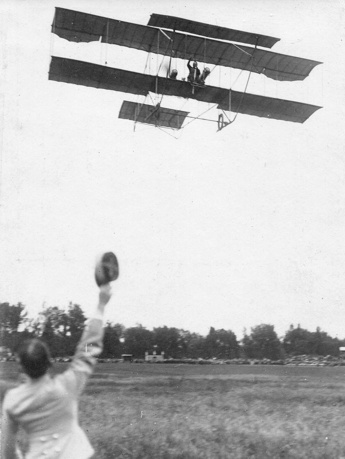
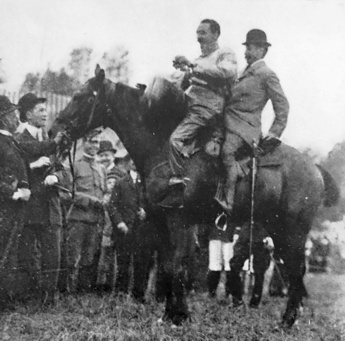

Angers is the capital of the department of Maine-et-Loire in western
France. It was a town already in Roman times and it was the capital of
the ancient province of Anjou, on the western border of France. It is
situated around 300 km southwest of Paris, on the river Maine, which is
one of the tributaries of the Loire. In 1910 the town had around 85,000
inhabitants, living from textile industry and trade in agricultural
produce and wine.
Like in several other towns in 1909 and 1910, the impulse to organize
an aviation meeting in Angers was partly due the cancellation of Grand
Prix automobile racing in 1909. The cancellation was caused by an
agreement between most of the major car manufacturers to boycott the
1909 season because of disagreements over regulations. One of the
cancelled races was the "Circuit d'Anjou".
In October 1909 a couple of Angers organisations raised the idea to
organize an aviation contest in 1910 instead. A committee was formed,
headed by René Gasnier (president) and Julien Bessonneau (secretary
general). The city council of Angers decided to contribute 25,000
francs, which enabled the planning to start. The military exercise
grounds in Avrillé, some three kilometres north of the city centre, was
selected as the best place to construct an airfield, and after some
discussions the military gave their permission. The meeting was
sanctioned by the Aéro-Club de France and in March 1910 a delegation
visited Angers to inspect the field. The committee also decided to
arrange the world's first cross-country aeroplane race, between
Angers and Saumur, a distance of around 43 kilometres.
The meeting attracted a field of nine pilots:
- Émile Aubrun, Blériot
- Jacques Balsan, Blériot
- André Crochon, Farman
- Bertram Dickson, Farman
- Daniel Kinet, Farman
- Georges Legagneux, Sommer
- Robert Martinet, Farman
- Walter de Mumm, Antoinette
- Marcel Paillette, Sommer
Crochon dropped out at a very late stage, only days before the start of the meeting. He was replaced by the Swiss Edmond Audemars, who planned to make the public debut of the Demoiselle, the light monoplane originally designed by Alberto Santos-Dumont and now license-built by the Clément-Bayard company. Unfortunately Audemars was not allowed to participate in the official flights. He had completed the qualification flights for his pilot's license a couple of days before the meeting, but the paperwork wasn't ready in time.
The first machine, Legagneux's Sommer, arrived on May 18th, followed by Dickson's Farman and the first of de Mumm's two Antoinettes the day after. Martinet had planned to fly his machine to Angers, but the meeting committee refused on the grounds that it was too close to the meeting and that they wanted to be sure that Martinet and his plane arrived safely and could perform at the meeting. After a three-day drive Martinet eventually arrived two days before the start of the meeting, having had to buy two Grégoire cars in order to tow his plane to the meeting!
Marcel Paillette on his Sommer was the first to make any flights on the Angers-Avrillé airfield, on June 1st. Those flights were actually his license qualification flights, observed by officials from the Aéro-Club de France. He was allowed to participate in the meeting, so his paperwork was apparently completed more quickly than Audemars'.
The day before the meeting the hangar area was open for visits, for a price of one franc. This was followed by a luxurious inauguration luncheon with speeches by René Gasnier and by the prefect of Maine-et-Loire and the mayor of Angers, Dr. Monprofit. At the end of the day Dickson made a successful test flight in front of the few remaining visitors.
There were celebrations all around Angers. Concerts with civilian and military orchestras and choirs were arranged every day during the meeting. All public buildings were illuminated and the mayor asked the people of the town to decorate their houses with flags during the meeting.
Friday 3 June
The weather on the morning of the first day of the meeting was warm and fairly calm, but some threatening clouds were already building up. Already at ten o'clock many people had gathered outside the airfield, but they had to wait until two o'clock before the gates opened, so they had to spend their time in the numerous bars and cafés arranged outside. The road from Angers to the airfield was a single-lane slow-moving queue of automobiles and carriages of all descriptions. Nothing happened at the airfield during the morning, only a couple of engine tests. Around 14:15 it started to rain, but when the rain stopped at 15:30 the red flag was hoisted in the signal mast.
Paillette was first in the air, at around 15:50, and flew several laps before landing safely. He was followed by Legagneux, who took off at 16:05 for a two-lap flight, immediately followed by de Mumm, who flew three laps. The next to start was Dickson, who immediately climbed to a greater altitude and made a very controlled flight of 23 laps, winning him the prize for the day's longest flight.
At five o'clock Martinet took off. After flying three laps at an altitude of some fifteen metres he was caught by an "air wave" and crashed. It was not very windy, but the air was quite turbulent in a couple of places due to the trees and woods around the airfields. Martinet was not injured and his machine was declared to be easily repairable, the main damages being a broken propeller and landing gear.
Around six o'clock the weather conditions improved and from then until half past seven the flights succeeded each other. De Mumm made three short flights, Legagneux two and Paillette one. The highest flight of the day was made by Balsan, who reached almost 100 metres during a flight of 15 kilometres, the day's second longest. But there was also a second crash - this time it was Dickson, who flew into the ground when turning too sharply: "I smashed my machine ... doing some fancy turns and got caught in a bad remous". Again damages were relatively minor and Dickson was unhurt.
Saturday 4 June
It started raining during the Friday evening, but it stopped during the night. During the morning it was again warm with only light winds, but a bit misty and cloudy. Already at half past eight Aubrun rolled out his machine for the first time. He made four test flights during the morning in order to ensure that his engine ran well. Daniel Kinet and his Farman arrived during the morning and his mechanics immediately started assembling it. At ten o'clock Legagneux flew two laps before climbing to 80 metres and passing over the trees at the northwest end of the airfield. He steered towards the village of Avrillé, where he circled the church tower before returning to land.
The grandstands were completely sold out and the cheap spectator areas were also filling up. Some people contented themselves by watching from the centre of Angers, where the signal mast and the observation tower were visible in the far distance from the main square, Place du Ralliement.
Legagneux started the afternoon's official flights by taking off at half past two. After flying for half an hour he made a five-minute stop to refuel, before taking off again. This time he remained longer in the air, circling and circling the course while getting some change by climbing to 125 metres for some laps, then flying first over the grandstands and then over the Bois de la Perrière forest north of the airfield. He landed after 58 laps to refuel one more time and took off at 16:42, but landed again after only a few minutes. At 17:20 he took off again and kept flying until he had completed a total of 110 laps of the 1.666 km course!
Paillette also made a good performance, covering 54 laps during four flights between 15:00 and 18:15. Aubrun completed some forty laps during three flights between 15:30 and 18:35, reaching an altitude of 150 metres and repeating Legagneux's feat of rounding the church tower of Avrillé. Balsan made two flights of in total 16 laps, complaining about turbulence. De Mumm had to land before completing his first lap, and Audemars flew a lap in pouring rain at 20:10, after the end of the official flying.
Sunday 5 June
The weather was calm and sunny in the morning. From ten o'clock until four in the afternoon the trams to the airport were completely full and the queue of cars and carriages reached the city centre. It was estimated that more than 50,000 people visited the airfield during the day. Those who couldn't get there watched proceedings from the Place du Ralliement and from the crowded roads outside the airfield.
The first to make a flight in the morning, before the official flights started at three o'clock, was de Mumm. He made a good take-off, but soon after the start he hit some turbulence over the Bois de la Perrière, lost control and crashed into the trees. De Mumm was not injured, but his machine was badly damaged and it took his mechanics and helpers all day to retrieve it, bit by bit, from the forest. At 13:45 Kinet rolled out his Farman for the first time and flew a lap. When he had landed Audemars made a four-lap flight, followed only minutes later by another flight of six laps, at a height of 15-20 metres.
When the cannon shot announced the start of official flights at three o'clock Legagneux was immediately in the air, followed three minutes later by Martinet and seven minutes later by Aubrun. The latter flew only one lap around the course and then turned above the grandstands, out of the airfield and circled Avrillé before landing to receive the ovations of the enthusiastic crowd. Next in the air was Paillette, who flew three laps as a prelude to a day of almost constant flying, broken only by short stops to fill the tanks, but never flying above 15-20 metres. At 15:40 Legagneux took off again and immediately climbed high. His engine ran very well and he appeared to be in complete and effortless control of his machine.
Around four o'clock Kinet took off, but a wheel buckled and pitched his machine into a fence. The machine was quite badly damaged, but the pilot escaped unharmed. At 16:05 Dickson took off in his repaired machine, but his engine didn't run well and he landed after three laps. He was followed by Martinet, who started a long and very regular flight at a height of 20 metres. After a short stop Dickson took off again, making it four planes around the short course. This inevitably led to some traffic, and the worst affected was Paillette. He had to take quick evasive action inside the course when Dickson came down over him from above, but he managed the sharp turn without difficulty. Dickson then climbed to the impressive altitude of 225-250 metres, before landing at 17:48 after cutting his engine for one of the long "vols planés" for which he was famous after the Tours meeting. The crowd followed his steep descent in anguish and greeted his safe landing with a "veritable explosion of bravos".
By that time Legagneux had completed 50 laps and Paillette 78, but Martinet kept turning and turning around the airfield, finally landing at 18:16 after covering 106 laps! Paillette landed and tried to take off again, but fouled his landing gear in the vegetation and had to stop. Legagneux suddenly took off at 18:54 and immediately climbed to an altitude of 200 metres. To the applause of the crowds he climbed even higher and turned southwards towards the centre of Angers. He reached 550 metres and made a big turn over the town, returning to land ten minutes later. The ecstatic crowd greeted him with by waved hats, handkerchiefs and umbrellas before carrying him on their shoulders. After telling about his flight between the castle and the cathedral above the enthusiastic crowds in the flag-decorated streets and on the Maine he was asked about his impressions. "Oh, c'est très chic", he simply replied.
The longest flight of the day, almost 126 kilometres, was made by Paillette, whose 195.55 km also won the day's total distance prize. Legagneux still led the contest for the longest total distance of the meeting with a margin of 36 kilometres, and he won the day's altitude prize by reaching an officially measured 238 metres. The total distance flown during the day was 609 kilometres.
The evening was celebrated by a concert and the aviators were invited by the mayor to a "vin d'honneur" at the town hall, together with dozens of VIPs and representatives of the press.
Monday 6 June
The weather again started calm, humid and very warm, but nobody made any flights in the morning. At nine o'clock the flyers visited Saumur by car to have a look at the landing field of the cross-country race, before immediately returning to Angers in order to complete their preparations. The landing airfield was the Prairie du Breil (apparently often spelled "Bray" in those days), a cavalry exercise ground on a peninsula bordered by the Loire and its tributary the Thouet, around 2.5 kilometres northwest of the centre of Saumur.
During the morning an additional contest was announced: two prizes of 1,000 and 500 francs for the longest total distance flown with a passenger. Around noon it started to rain rather heavily, but the weather improved after a couple of hours and when it was time for the official flights to start at three o'clock the red flag was hoisted. Five minutes later Paillette took off, as usual flying low, slow and safe. He was followed almost immediately by Dickson, who flew lap after lap with one of his mechanics as passenger. At 15:15 Legagneux took off and flew 25 laps before leaving the airfield and circling the church tower of Avrillé in order to "evaluate the state of the atmosphere" before the cross-country race. At five o'clock the cannon announced that flights at the airfield stopped in preparation for the cross-country race. Paillette and Dickson had flown 65 laps and Legagneux 64. Dickson's flight of 98.75 kilometres won him the prize for the longest passenger flight. De Mumm made a short test flight of two laps in his reserve machine, but didn't manage to gain any height.
It had been announced that Martinet, de Mumm, Legagneux and Dickson would contest the Angers-Saumur race. The four pilots lined up their machines on the field. The flyers were supposed to take off at five-minute intervals. Conditions were again perfect, with almost no wind. Martinet was first to start, at 17:20. He immediately climbed high and left the airfield, visible for several minutes as a little dot against the sky in the south-east. At 17:25 de Mumm tried to take off, but he didn't manage to lift off despite rolling hundreds of meters on the ground. He taxied back to the hangars and withdrew from the race, disappointed and furious. At 17:30 Legagneux took off. He chose a more easterly course than Martinet, but appeared to fly fast. He flew lower than Martinet and soon disappeared from view. Dickson was next, but the tail of his machine was damaged while manoeuvring on the ground, "broken by some fools of workmen holding it just as I was starting", according to the pilot. The repairs delayed his take-off until 17:45, the loss of almost eleven minutes of course putting him out of contention for the win. He took a more southerly course and turned to the right over the town, probably in order to find the Loire as quickly as possible.
Most of the spectators left the airfield immediately when the flyers had left, but some stayed, since Legagneux had said he would fly back after the race. Thousands of people followed the flights, in the streets of Angers and all the towns and villages along the Loire, and from roofs and chimneys. At six o'clock the first news of the results were reported back to René Gasnier via the specially arranged telephone lines.
None of the pilots had any incidents during the flight, which all made at altitudes of 250 to 500 metres. The only exception was Legagneux, who had a wire come loose during the flight and worried that it might find its way into the propeller, but in the end nothing happened. There were plenty of landmarks along the way to help navigation, from the cathedral and the "Tour au Plomb", the lead factory tower, in central Angers to the church towers of Saint-Léonard, Saint-Barthélemy and Saint-Mathurin, and finally the Loire.
The Prairie du Breil was full of people, eagerly expecting the aviators. The grandstands were sold out and the soldiers tasked with keeping the airfield clear had a hard time. The municipality of Saumur had organized several events in connection with the race, among them several concerts, a gymnastic show and a football match between teams from Saumur and Angers. Two balloons would fly from the airfield, there would be a kite-flying contest and a flock of homing pigeons would be released.
Martinet was first to arrive, at 17:51. He landed immediately after a short glide and was greeted by the mayors of Saumur and the neighbouring commune of Saint-Florent. Fifteen minutes later Legagneux also passed the finish line. He didn't land at once, but flew several turns over the town and the castle of Saumur before landing, thus winning the 1,000 francs prize for the longest flight over the airfield. A further fifteen minutes later Dickson finally arrived, flying very high. He claimed that since head lost so much time on the ground he "started for sport, rose to 3,000 feet en route and vol planed down from 1,200 feet to astonish the natives". He happened to land in a part of the field that was still wet after being flooded only days before and had to be rescued on horseback from the foot-deep water.
Martinet had won, his time of 31:35 beating Legagneux's 36:25 and Dickson's 44:53. After the landings the crowds broke through the fences in order to get a closer look at the aeroplanes and the pilots. When Legagneux's mechanics arrived by car it was decided that he wouldn't fly back after all. The remaining crowds at Avrillé received the message at half past eight and had to leave disappointed, and Legagneux eventually returned to Angers by car at 22:15. All the machines were dismantled at Saumur and removed by road.
Conclusion
Martinet and Paillette made some short flights on the Tuesday, but otherwise the flyers quickly disassembled and packed their planes. Audemars rushed to the Port-Aviation meeting, which started already the following weekend. Paillette and Dickson travelled to the Rouen meeting, which started less than two weeks later, where they would once again meet the busy Audemars. As usual, work immediately started on dismantling and removing the temporary airfield installations. The timber used for all the fences around the airfield had been announced for sale in the local newspapers already before the meeting started!
The meeting had been a complete success, bringing lots of business and visitors to the town. The railway and tram lines had transported almost 50,000 people to the meeting and when the financial results had been calculated it was announced that the sponsors would get almost all their money back. The weather hadn't caused any major troubles and flyers had completed a total distance of 1,398.795 kilometres with no major accident.
The fact that the Angers-Saumur race was the first of its kind was of course noted in the aviation press of the time, but didn't really make headline news. The press was full of spectacular flying exploits every week, for example Charles Rolls' double crossing of the English Channel, which happened around the same time, and the start of the Budapest meeting, with the biggest prize fund of the season.
